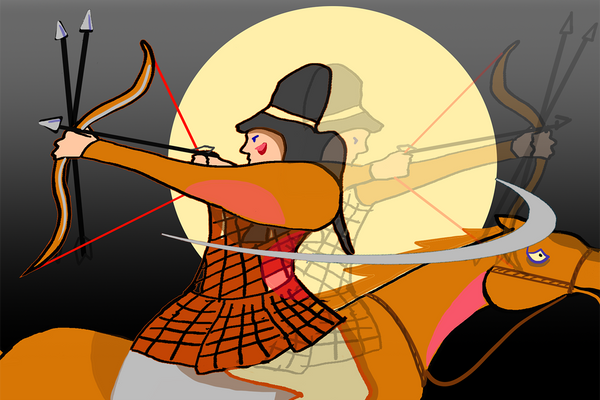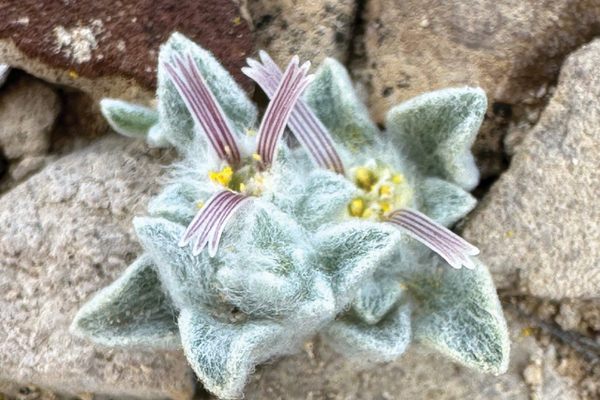
Meet the Artist Making Fauna Out of Flora
Raku Inoue is now finding inspiration for his precise, ephemeral works in his backyard.
There’s a lively, sculptural presence to the creatures created by Canadian artist Raku Inoue, simply made of blooms and leaves. Elegant representations of insects and animals emerge from the natural materials, which he normally acquires from both local flower shops and flower farms abroad.
Occasionally, Inoue has found inspiration in his own backyard, and this has been especially true during the coronavirus quarantine in his Montreal home. “I was scraping off the thick layers of fallen autumn leaves and guiding the spring sunlight toward the soil when I noticed many sprouts and shoots hidden underneath,” he wrote on his Instagram. “It’s nice to see that outdoor life thrives regardless of the pandemic lockdown.” The early blossoms in his garden led him to create a series of smaller and quieter pieces—micro-insects—that seem fitting during the shelter-in-place. “My art is about being appreciative of the small things in life and enjoying each moment as time is precious and life is ephemeral,” the artist writes in an email.
No matter how beautiful his artworks are, the artist is practical and philosophical about their shelf-life, which is short. After Inoue has photographed his completed works, he immediately recycles them back to Mother Nature. And he hopes his viewers will both enjoy their appearance and recognize the cyclical character of the natural world. “It’s also understanding and accepting that not everything is forever, especially in nature, and that sometimes there is beauty in letting things go,” he says. “If I can get some of my audience to feel this way, then I have accomplished my true goal.”

Atlas Obscura spoke with Inoue about his time-driven process, his inspiring childhood, and his garden.
What first motivated you to start using natural elements to make art?
One day, three years ago, it was windy and the fragile petals of roses in my backyard were blown off to the ground. I picked them up and made my first floral insect: a small beetle. The fascination for the crawly creatures is something that goes back to my childhood growing up in Japan, where I used to catch kabutomushi (Japanese horned beetles) with my grandmother. I also remember spending wonderful time inside encyclopedias, feeding my curiosity and learning about many things that exist on this planet, including plants and insects. So I think it was only natural that I find myself gravitating toward these subjects for inspiration.
What materials do you especially like to work with?
Most of the time, I purchase them from a local flower shop. Occasionally they kindly donate leftover flowers. I had a flower farm in Ecuador shipping me flowers in the past, which I used to create some of the most colourful work, and those were a delight to work with. With the northern climate of Canada, most outdoor plants and flowers are not available throughout the year, but when they are, I use them quite regularly and it adds to my creations a sense of seasonality. Some of my favorite flowers are seasonal and grow right in my backyard: daffodils, hydrangea, clematis, plum tree flowers. I bought a house six years ago and one of the selling points was that it came with a spacious backyard. At that point, I never had a garden to take care of or maintain, but I have witnessed my mother working hers, and that definitely influenced me to start my own. Come mid-summer, plants and flowers will have completely swallowed the entire landscape, and surrounding trees will have completely separated us from our neighbors. The city life can be overwhelming at times, so it is nice to have a retreat where I get to disconnect. Currently, due to the pandemic, all nonessential businesses are closed, including flower shops, so I am glad that the blossoming season is upon us. This year’s first floral bloomers were daffodils. But sprouts and shoots were starting to thrive a little ahead of time. I used these to make the micro-insects series. The ingredients vary, from shoots of a kiwi tree to lilacs to tulips. Us humans may be on lockdown but nature is not, fortunately.

Can you describe your process?
It really depends on the complexity of the work. It can take 20 minutes, more or less, for a regular-sized arrangement. For something more ambitious, it can take up to a week or more. The most important factor that needs to be considered every time I’m creating is that I am using ephemeral materials that are destined for decomposition. Therefore it is a race to the finish line, and the end goal is capturing with my camera the freshness and the liveliness of the materials before they wither away. Once the whole process of creation has been completed, I discard the used materials in the compost bin. It is a give-and-take relationship with the precious ingredients.
Do you have a particular favorite among your work?
One day I was cleaning my backyard, collecting pine cones, and suddenly it hit me. How these round cones could be glued together to achieve any shape imaginable. First I thought about a human face, then I thought about the pine cone scales and how they look rough and tough. So I ended up choosing a gorilla for a subject. All this was a lovely reminder that inspiration can come from anywhere. For me, finding inspiration is not an action to take but rather a state of mind where you become sensitive to everything that surrounds you. Anything can be inspiring, and with time this becomes a part of who you are. Finding inspiration becomes more and more natural.
This interview has been edited for clarity and length.










































Follow us on Twitter to get the latest on the world's hidden wonders.
Like us on Facebook to get the latest on the world's hidden wonders.
Follow us on Twitter Like us on Facebook